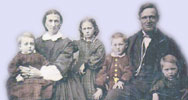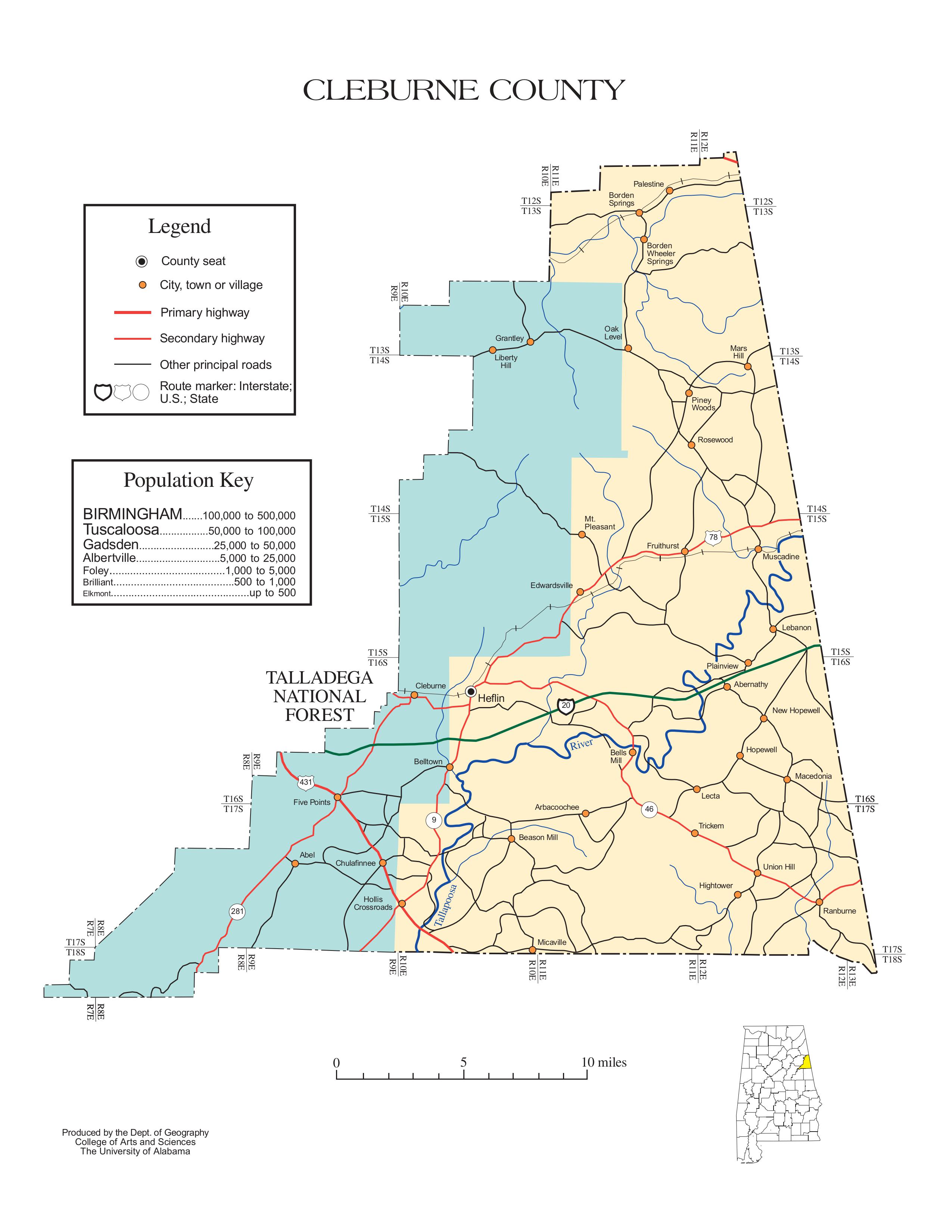Cleburne County, Alabama Database
Map courtesy of Alabama Maps
Cleburne County, Alabama, established in 1866 and named for Confederate General Patrick R. Cleburne, is located along the eastern border of Alabama with Georgia. Its county seat is Heflin, a town that grew with the arrival of the Southern Railway, leading to the relocation of the county seat from Edwardsville in 1906. The county is known for its rugged landscapes, much of which is covered by the Talladega National Forest, and for being home to Cheaha Mountain — Alabama’s highest point — and Cheaha State Park. The region remains largely rural, characterized by small communities, forests, and scenic vistas.
Historically, Cleburne County was inhabited by Native American tribes, primarily the Creek, before European settlement. The area saw a brief gold rush during the 1830s and 1840s, particularly in Arbacoochee, once a thriving mining town. Agriculture, gold mining, and later forestry shaped the local economy over the years. Today, remnants of that history can be seen in its ghost towns, historic cemeteries, and small churches that still dot the countryside, reflecting the county’s rich and varied past.
You can click the names of each town below to be taken to its history section.
Incorporated Communities
Heflin ♦ Edwardsville ♦ Fruithurst ♦ Ranburne
Unincorporated Communities
Abel ♦ Abernathy ♦ Arbacoochee ♦ Belltown ♦ Beason Mill ♦ Bells Mill ♦ Borden Springs ♦ Borden Wheeler Springs ♦ Chulafinnee ♦ Five Points ♦ Grantley ♦ Hightower ♦ Hopewell ♦ Hollis Crossroads ♦ Lebanon ♦ Lecta ♦ Liberty Hill ♦ Macedonia ♦ Mars Hill ♦ Micaville ♦ Mt. Pleasant ♦ Muscadine ♦ New Hopewell ♦ Oak Level ♦ Palestine ♦ Piney Woods ♦ Plainview ♦ Rosewood ♦ Trickem ♦ Union Hill
| Return to States | Return to Alabama Counties |
| Categories | Data Avail. |
|---|---|
| Census Records | No |
| Cemeteries | View Information |
| Churches | No |
| Church Records | No |
| Cities | No |
| Court Records | No |
| Directories and Voter Registers | No |
| Historic Post Offices | No |
| Immigration and Naturalization Records | No |
| Land and Property Records | View Information |
| Military Records | No |
| Newspapers | No |
| Probate Records | No |
| Schools | No |
| Vital Records | No |
Heflin
Heflin became the county seat of Cleburne County in 1906, and that changed the town’s future. The move from Edwardsville to Heflin primarily occurred because the railroad passed through, making Heflin a more convenient location for business and government. The train brought new life to the town, helping it grow as people and goods could get in and out more easily. What started as a small farming community quickly evolved into a bustling hub where people came to trade, shop, and conduct county business.
Before all of that, Heflin was a quiet spot in the countryside. The people who lived there mostly farmed or worked in the timber industry, and life moved at a slower pace. But when the Southern Railway arrived, things changed fast. Stores, schools, churches, and a courthouse began to appear, and Heflin became a genuine center of activity in the county. The town grew in response to the needs of its people and the opportunities that came with improved transportation.
Today, Heflin still retains its small-town feel, even as it serves as the heart of Cleburne County. Its downtown has pieces of the past that folks enjoy exploring, and it’s a short drive from places like Cheaha State Park and the Talladega National Forest. The town’s story is still tied to the land, the railroad, and the people who’ve called it home over the years.
Edwardsville
Edwardsville is where Cleburne County got its start. When the county was formed back in 1866, Edwardsville was chosen as the first county seat, and for a while, it was the center of activity. Folks would come into town to conduct business at the courthouse, pick up what they needed from the local shops, or catch up with neighbors. It might’ve been small, but Edwardsville brought people together and helped the county take shape in those early days.
Things started to change when the railroad came through Heflin instead of Edwardsville. With the trains passing through Heflin, that’s where the trade and travel shifted. Heflin grew, and little by little, Edwardsville became a quieter place. By 1906, the county seat had officially moved to Heflin, and Edwardsville settled back into being a peaceful, rural community. But life didn’t stop there — the families who stayed continued to farm, work the land, and hold onto the town’s spirit.
Today, Edwardsville isn’t a bustling town anymore, but it still means a lot to the folks in Cleburne County. The land, the old buildings that are still standing, and the stories passed down through the years all remind us of where the county began. Edwardsville’s history runs deep, and it’s still a proud part of the county’s story.
Fruithurst
Fruithurst is one of those small towns with a story that not everyone knows, but it’s worth sharing. Back in the late 1800s, folks came to this corner of Cleburne County with big hopes. They saw the hills, the good soil, and the mild weather, and thought it’d be the perfect place for vineyards. For a while, they were right. Grapevines covered the land, and the town grew as people showed up to work the fields and try their hand at the wine business. New houses were being built, stores were opening, and even a hotel was being constructed for visitors coming to see what Fruithurst was all about.
That chapter didn’t last forever. The temperance movement and new laws against alcohol put an end to the wine business, and Fruithurst had to figure out what came next. The vineyards faded, and the town got quieter. But the people here didn’t pack up and leave. They planted other crops, kept working the land, and made a good, honest living. Life slowed down, but the community remained strong, helping one another through the changes. Fruithurst didn’t disappear — it just found a different way forward.
Today, Fruithurst is a small, peaceful place, but those old vineyard days remain an integral part of its story. The hills where the grapevines once grew are still there, and folks haven’t forgotten how it all began. The town may not be big, but the pride people have in it runs deep. Fruithurst is a reminder of what it means to start with a dream, face difficult times, and persevere no matter what.
Ranburne
Ranburne is one of those small towns where everybody knows everybody, and folks wouldn’t have it any other way. It sits down near the Georgia line, tucked away where life tends to move a little slower. For as long as anyone can remember, Ranburne has been a place where neighbors help neighbors, and the sense of community runs deep. The town’s roots are in farming, and generation after generation, families here have worked the land, raised their kids, and built lives that are simple, honest, and steady. Even as the world has sped up, Ranburne has held onto its small-town spirit, which folks appreciate.
The town never tried to get too big, just big enough to meet the needs of the people who call it home. Churches, schools, and a few local shops have long been the heart of the community — places where people gather, share stories, and lend a hand. The school has always been a significant source of pride in Ranburne. It’s where folks come together for ball games, school plays, and other events that remind everyone what community is all about. While some places saw booms and busts, Ranburne has stayed true to itself, where tradition and a sense of belonging matter more than anything else.
These days, Ranburne is still that quiet, friendly town where visitors are greeted with a smile and a wave. People often say they feel right at home when they stop by, and the folks who live there wouldn’t trade it for the world. With its deep ties to the land and one another, Ranburne continues to be a special part of Cleburne County. In this place, hard work, faith, and good neighbors are at the heart of everyday life.
Arbacoochee
Arbacoochee’s not much more than a name on a map these days, but there was a time when it was full of people and promise. When gold was found out that way in the 1830s, folks came from everywhere, hoping to hit it big. For a while, the town was alive — stores, a hotel, even its newspaper. It was the kind of place where the streets stayed busy, and everyone was chasing the same dream. People came with what little they had, set up tents or built small homes, and tried their luck.
It didn’t last long. Like a lot of gold towns, once the easy gold was gone, so were most of the people. The stores closed, the noise faded, and Arbacoochee settled back into being just another quiet spot in the hills. A few families stayed behind, farming the land or making the best of what life had to offer. But that rush of people and energy — that was over.
Now, what’s left of Arbacoochee is mostly memories and a few old cemeteries or stone foundations, if you know where to look. Folks around here still talk about it, though. It’s part of the county’s story — a place that saw big hopes come and go, and where the land itself holds onto what’s left of those days.
For those interested in learning more, Lenore Martin spent years gathering stories, records, and photos about Arbacoochee. You can explore her collection here to see what she uncovered about this once-bustling gold town. Courtesy of the Alabama Room making her work available online.
Chulafinnee
Chulafinnee’s not much more than a name folks mention now and then, but there was a time when it was a busy little spot. In the 1830s and 1840s, gold drew people to this area. They came with what they had, hoping to find enough to build a better life. For a while, the town had what you’d expect — a few shops, a post office, and plenty of people trying their luck. The name itself comes from a Creek word, and the place always felt tied to the land in some way.
It didn’t last. Like most gold towns, once the easy gold was gone, so were the crowds. Little by little, folks moved on to other places, and Chulafinnee got quiet again. A few families stayed behind, working the land and making do, but the town that once had so much going on faded back into the hills.
If you go out that way now, you’ll find a few old foundations, maybe a cemetery or two if you know where to look. But people around here still remember. Chulafinnee might not be on the maps like it once was, but it’s part of the county’s story. A place where people came chasing a dream, and the land’s still holding the memory of it.





